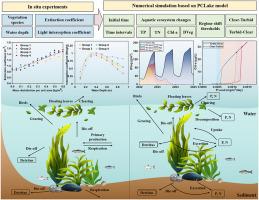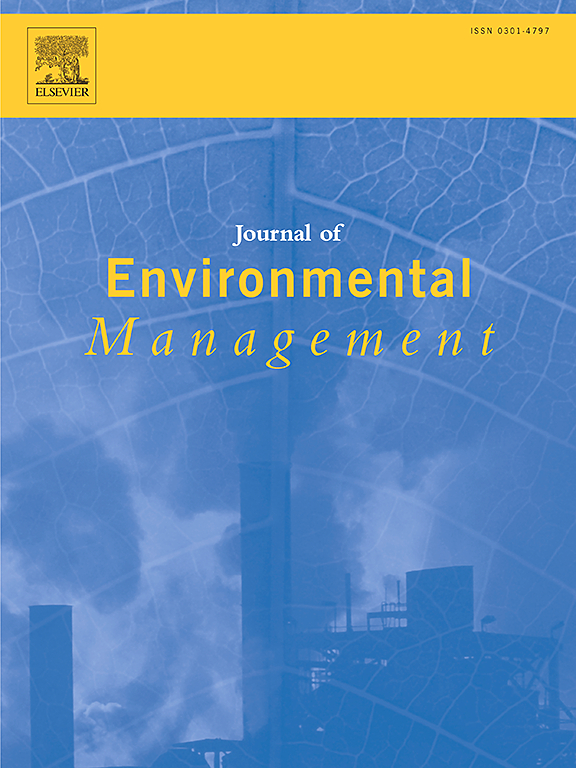清除漂浮的沉水植被叶片:稳定浅水湖泊清澈状态的有效管理方法?
IF 8
2区 环境科学与生态学
Q1 ENVIRONMENTAL SCIENCES
引用次数: 0
摘要
在富营养化的浅水湖泊中实现可持续的清澈状态具有挑战性,因为营养物质负荷的减少与生态系统的反应之间存在滞后性,这往往会导致湖泊生态环境的转变。由于刚恢复的湖泊不稳定,沉水植被往往会脱落并漂浮到水面,阻挡光线,这是影响湖泊是否再次恶化的一个关键特征。然而,这种瞬时遮蔽与水系变化之间的关联机制仍不清楚。本研究进行了原位实验,量化了漂浮的沉水植被叶片的遮蔽效应。我们引入了新的参数、光拦截系数和函数,它们是连接实验结果和数值模型的重要纽带。值得注意的是,我们开发了一个创新模块,专门用于评估不同清理措施对水生生态系统的影响,该模块已无缝集成到 PCLake 模型中。我们将这一实用模型应用于最近进行生态修复的兴隆湖,模拟了主要生态指标(总磷(TP)、总氮(TN)、叶绿素 a(Chl-a)、沉水植物生物量(DVeg))的变化,并确定了不同营养负荷、初始时间和清叶时间间隔下的制度转变阈值。实验结果表明,光截获系数呈现出一种微妙的模式,最初随水深的增加而略有增加,然后逐渐下降,对于 Vallisneria natans 而言,范围在 0.573 m2/kg 至 0.982 m2/kg 之间。情景模拟结果表明,将清湖间隔时间从 0 天延长到 120 天,会导致 TP、TN 和 Chl-a 浓度升高,同时 DVeg 下降,甚至导致湖水浑浊。事实证明,如果湖泊生态系统发生了变化,那么在停止一段时间后恢复每日清淤并不能有效恢复湖泊生态系统。随着养分负荷和截流系数的增加,引发水体变化的时间间隔也在缩短。我们保守地建议,清叶间隔不应超过 10 天,最好在 3 月份之前开始,以确保沉水植被有足够的光照。这项研究为了解浮叶的瞬时遮蔽对水系转换的影响提供了宝贵的见解,并为保持浅水湖泊的可持续清澈提供了科学指导。本文章由计算机程序翻译,如有差异,请以英文原文为准。

Clearing floating submerged vegetation leaves: An effective management to stabilize the clear state in shallow lakes?
Achieving sustainable clear states in eutrophic shallow lakes is challenging due to the lag between nutrient load reductions and ecosystem response, often resulting in regime shifts. Submerged vegetation tends to fall off and float to the surface and block light due to the instability of freshly restored lakes, a key feature in influencing whether lakes deteriorate again. However, the mechanisms linking such transient shading to regime shifts remain unclear. This study conducted in situ experiments that quantified the shading effect of floating submerged vegetation leaves. We introduced the novel parameters, light interception coefficients and function that served as a crucial link between experimental findings and numerical models. Notably, we developed an innovative module specifically designed to assess the impacts of different clearing measures on aquatic ecosystems, which had been seamlessly integrated into the PCLake model. This practical model was applied to Xinglong Lake, recently ecologically restored, to simulate variations in key ecological indicators (total phosphorus (TP), total nitrogen (TN), chlorophyll-a (Chl-a), submerged vegetation biomass (DVeg)) and identify regime shift thresholds under different nutrient loads, initial time and time intervals of leaf clearing. The experimental results showed that light interception coefficients exhibited a subtle pattern, initially increasing slightly with water depth before declining, ranging from 0.573 m2/kg to 0.982 m2/kg for Vallisneria natans. The scenarios simulations demonstrated that prolonging clearing intervals from 0 to 120 days resulted in elevated TP, TN, and Chl-a concentrations, accompanied by a decline in DVeg, even causing the lake to a turbid state. Resuming daily clearing after a period of cessation proved ineffective in restoring the lake ecosystem if a regime shift had occurred. As nutrient loads and interception coefficients increased, the time intervals for triggering regime shifts shortened. We conservatively recommended that leaf clearing intervals should not exceed 10 days and ideally begin by March to ensure sufficient light for submerged vegetation. The study provides valuable insights into the impact of transient shading from floating leaves on regime shifts and offers scientific guidance for maintaining shallow lakes sustainably clear.
求助全文
通过发布文献求助,成功后即可免费获取论文全文。
去求助
来源期刊

Journal of Environmental Management
环境科学-环境科学
CiteScore
13.70
自引率
5.70%
发文量
2477
审稿时长
84 days
期刊介绍:
The Journal of Environmental Management is a journal for the publication of peer reviewed, original research for all aspects of management and the managed use of the environment, both natural and man-made.Critical review articles are also welcome; submission of these is strongly encouraged.
 求助内容:
求助内容: 应助结果提醒方式:
应助结果提醒方式:


